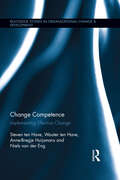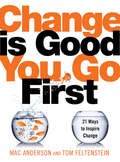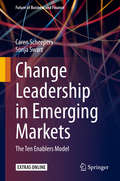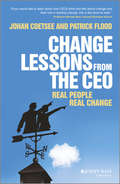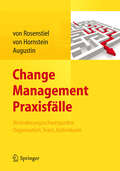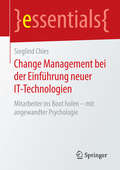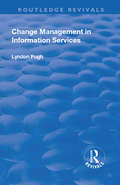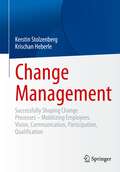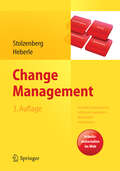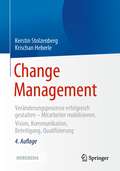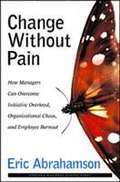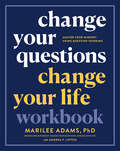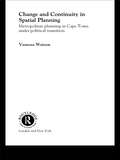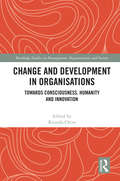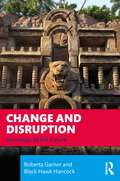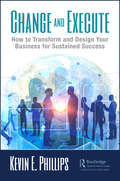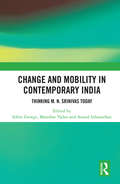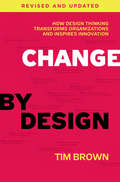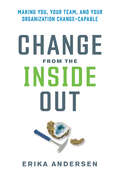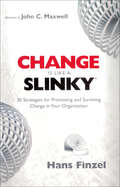- Table View
- List View
Change Competence: Implementing Effective Change (Routledge Studies in Organizational Change & Development #9)
by Steven ten Have Wouter ten Have Anne-Bregje Huijsmans Niels van der EngOrganizations are often forced to change and adapt as a result of internal or external circumstances – whether the impetus is vision and ambition, a competing organization, societal pressure, or financial pressure. In this book, the authors posit that successful change requires the coherence of five elements: rationale and effect, focus and energy, and connection. In Change Competence, they present a vision of change management centered around these five elements, along with a model and method for diagnosing, approaching, and developing change management in a purposeful way. The book demonstrates the nuances and applications of the change management model with the use of a single integrated case, from identifying elements ripe for change, to coping with barriers, to varying approaches to change, to the different leadership roles that emerge in relation to the five key elements of change management. This book will be of interest to practitioners and students in change management, organizational behavior, and organizational development.
Change Is Good...You Go First
by Mac Anderson Tom FeltensteinHow does your team react to change? Do they dig in with their heels to resist it or do they welcome it with open arms?As leaders, we know that change is a fact of life and we need to learn to manage it before it manages us. A tall order? Not when you have the wisdom of two business icons, Mac Anderson and Tom Feltenstein, to show the way. This easy-to-use book will help you and your team stop conducting business as usual.Change is the key that unlocks the doors to growth and excitement in any organization. More importantly, without it...your competition will pass you by.You don't have a choice about change, but you do have a choice about how you and your team react to it.Don't wait another minute to inspire, motivate, and encourage your team to move forward and embrace change. Lead the way. You go first.
Change Leadership in Developing Countries
by Franca OvadjeSelected as an Outstanding Academic Title by Choice Magazine in 2014! In Change Leadership for Developing Countries, Franca Ovadje offers readers a comprehensive and integrative model for the design, implementation and evaluation of organizational change. This unique book embodies an African perspective, discussing the specific needs and issues associated with leading change within the institutional, economic, social, and cultural contexts of developing economies. Based on extensive research, as well as the first-hand experiences of managers who have led change initiatives in Africa, this book envisions a change leadership model based on conscious decision-making, rather than taking a prescriptive approach. With examples and case studies drawn from African organizations, this book is a vital tool for students and managers who are based in, or interact with, emerging economies.
Change Leadership in Emerging Markets: The Ten Enablers Model (Future of Business and Finance)
by Caren Brenda Scheepers Sonja SwartBased on neuroscience research, this book presents and demonstrates a 'Ten Enablers' model as a framework to help change leaders successfully lead and manage change. It focuses on the execution of change processes within volatile and challenging emerging markets with high growth potential. The book first presents the organizational development and change research on which the model is based, and discusses the basic neuroscience principles. It then introduces a systematic model of the ten enablers, taking readers through the process of change, from considering the ethos prior to embarking on it, including engagement of stakeholders, up to the final phase, where change leaders exit the process or the organization. It highlights this circular process through several step-by-step illustrations, supported by examples from emerging markets. Further, it includes neuroscience research and principles to help leaders understand and manage change in themselves and others. This well-researched and practical book is a valuable resource for students and professionals alike.
Change Lessons from the CEO
by Johan Coetsee Patrick C. Flood"5 stars: Exceptional, a must read for any manager or leader" - Sarah Stocks - Chartered Management Institute (CMI)"This book is a highly effective, meaningful and user-friendly guide for anyone trying to manage change in a modern organisation today" - inManagement magazineReal stories from real CEOs on implementing successful change initiatives in any organizationChange is difficult. In large organizations with established cultures, managing change can be one of the biggest challenges for business leaders and managers. Using a wealth of real stories from real CEOs on how they managed major change initiatives--and the lessons they learned along the way--Change Lessons from a CEO gives professionals and business students powerful and effective guidance on successfully managing change initiatives in any organization. The book's uniquely flexible approach lets readers build their own models for change based on their unique organizational structure, culture, and situation. Throughout, the book emphasizes the importance of authenticity in the change leader's role and how to manifest that authenticity throughout a change initiative. With examples and case studies from multinational corporations, non-governmental organizations, and small and medium-size businesses, this book is a valuable tool for leaders of any organization of any size.Offers real-world insight from CEOs and leadersIdeal for CEOs, managers, leaders of non-profit organizations, consultants, and students in business programsIncludes case studies and first-hand accounts of successful change initiatives in a wide range of businesses and organizations of all sizesChange is inevitable. Managing change initiatives successfully can be the difference between organizations and teams that thrive and those that come apart at the seams. For business leaders and students, this book offers practical and proven guidance for doing change right.
Change Management Praxisfälle: Veränderungsschwerpunkte Organisation, Team, Individuum
by Elisabeth Von Hornstein Lutz Von Rosenstiel Siegfried AugustinUnter Change Management sind meist bereichsübergreifende Veränderungsprozesse in Organisationen zu verstehen. Ob der Fokus klassisch bei einer Restrukturierung liegt, die Teamebene oder die Personalentwicklung betrifft, der Band bietet für jeden dieser Veränderungsprozesse die passenden Praxis-Tools: mit Ablaufschemata, Gesprächsleitfäden und Checklisten. Dabei gehen die Autoren besonders auf die Kernbereiche von Organisationen ein, die sich häufig als "Nadelöhr" für den Erfolg herauskristallisieren und deshalb erhöhte Aufmerksamkeit benötigen.
Change Management and the Human Factor: Advances, Challenges and Contradictions in Organizational Development
by Frank E. P. Dievernich Kim Oliver Tokarski Jie GongChange management and organizational development is unthinkable without people. Human beings form its core as both subjects and objects of change. This volume attempts to cut through to the core of change management, to the people that stand at its heart and focuses on their intrinsic role in change management and organizational development. Topics covered in this volume encompass the human element within organizational change, how this impacts roles, dynamics of team interaction and affects the workplace in teaching and learning settings. It also addresses resistance to institutional and organizational change and the central role that agile management plays in this process.
Change Management bei der Einführung neuer IT-Technologien: Mitarbeiter ins Boot holen – mit angewandter Psychologie (essentials)
by Sieglind ChiesSieglind Chies vermittelt, dass Einführungen neuer IT-Technologien je nach Anzahl der veränderten Arbeits- oder Prozessschritte als Veränderungsprojekte betrachtet werden sollten, da sie häufig Widerstand innerhalb der Belegschaft mit sich bringen. Für dessen Bewältigung ist es sinnvoll, nicht nur technologische, sondern auch arbeitspsychologische Maßnahmen zu treffen. Nach den Phasen, die der Einführung eines neuen ERP-Systems vorausgehen, erläutert die Autorin ein einfaches arbeitspsychologisches Modell, das zeigt, wie Mitarbeitende auf die anstehende Veränderung vorbereitet werden können. Anhand von konkreten Beispielen aus dem IT-Kontext erklärt sie, wie sich dieses Modell im Rahmen einer ERP-Einführung anwenden lässt. Ergänzend dazu stellt die Autorin weiterführende psychologische Grundlagen kurz und prägnant vor.
Change Management in Information Services
by Lyndon PughThis title was first published in 2000: An overview of change management and organizational theories. The book explores the strategies normally associated with them and presents real solutions to real problems for services spanning the academic, public and commercial sectors. Through a series of case studies, the book shows how different organizations and personal issues need equally different approaches to managing them. The author demonstrates how discrete change projects can be modelled, implemented and reviewed and explains the advantages and disadvantages of various organizational structures in managing change. He takes a candid look at what really makes teams tick or malfunction and, focusing particularly on people issues, suggests how adapting management styles and providing training can help to meet the demands of change.
Change Management: Successfully Shaping Change Processes – Mobilizing Employees. Vision, Communication, Participation, Qualification
by Kerstin Stolzenberg Krischan HeberleViele Veränderungsprojekte in Unternehmen scheitern daran, dass die erfolgskritische Frage des Change Managements ignoriert wird: Wie bindet man Mitarbeiter ein? In dem Buch zeigen erfahrene Organisationsentwickler die Bedeutung von Vision und Ziel, Kommunikation, Beteiligung und Qualifizierung für erfolgreiche Veränderungsprozesse. Die Autoren liefern konkrete Handlungsanleitungen, detailliert beschriebene Vorgehensweisen, Ablaufschemata, Gesprächsleitfäden und Checklisten. Die 3. Auflage wurde komplett überarbeitet und um weitere Tools ergänzt.
Change Management: Veränderungsprozesse erfolgreich gestalten - Mitarbeiter mobilisieren. Vision, Kommunikation, Beteiligung, Qualifizierung
by Kerstin Stolzenberg Krischan HeberleViele Veränderungsprojekte in Unternehmen scheitern daran, dass die erfolgskritische Frage des Change Managements ignoriert wird: Wie bindet man Mitarbeiter ein? In dem Buch zeigen erfahrene Organisationsentwickler die Bedeutung von Vision und Ziel, Kommunikation, Beteiligung und Qualifizierung für erfolgreiche Veränderungsprozesse. Die Autoren liefern konkrete Handlungsanleitungen, detailliert beschriebene Vorgehensweisen, Ablaufschemata, Gesprächsleitfäden und Checklisten. Die 3. Auflage wurde komplett überarbeitet und um weitere Tools ergänzt.
Change Management: Veränderungsprozesse erfolgreich gestalten - Mitarbeiter mobilisieren. Vision, Kommunikation, Beteiligung, Qualifizierung
by Kerstin Stolzenberg Krischan HeberleViele Veränderungsprojekte in Unternehmen scheitern daran, dass die erfolgskritische Frage des Change Managements ignoriert wird: Wie bindet man Mitarbeiter ein? In dem Buch zeigen erfahrene Organisationsentwickler die Bedeutung von Vision und Ziel, Kommunikation, Beteiligung und Qualifizierung für erfolgreiche Veränderungsprozesse. Die Autoren liefern konkrete Handlungsanleitungen, detailliert beschriebene Vorgehensweisen, Ablaufschemata, Gesprächsleitfäden und Checklisten. Die 3. Auflage wurde komplett überarbeitet und um weitere Tools ergänzt.
Change The World, Change Your Life: Discover Your Life Purpose Through Service
by Angela Perkey18,000 children die of hunger every day. By 2030, there will be no glaciers in Glacier National Park. 47 million Americans do not have health insurance. The economy's in turmoil. Job loss. Foreclosures. Illiteracy. It's easy to feel powerless in the face of such depressing news. And yet many people in today's generations are more eager than ever to get involved, to do something, anything, to improve the world. They crave meaningful lives that are worth remembering. Change the World, Change Your Life shows you how to get involved and effectively address the problems you care about most, from your own backyard to the world stage. It provides a blueprint for being of service and includes practical resources for making a difference in a way that will also change your life. Interlaced with stories of individuals who have found ways to give, large and small, it is exactly the right book for these times.
Change Without Pain: How Managers Can Overcome Initiative Overload, Organizational Chaos, and Employee Burnout
by Eric AbrahamsonChange or perish is a corporate truism, but so is its unhappy corollary: many companies change and perish. The process of change can tear an organization apart. Drawing on his research over ten years, the author suggests that companies alternate major change initiatives with carefully paced periods of smaller, organic change, using processes he calls tinkering and kludging (kludging is tinkering on a large scale). The result is dynamic stability, which allows change without fatal pain. Citing examples from General Electric to Barnesandnoble.com, the author describes dynamic stability as a process of continual but relatively small reconfigurations of existing practices and business models rather than the creation of new ones. As they tinker and kludge, successful companies would be wise to follow these four guidelines: reward shameless borrowing; appoint a chief memory officer who can help the company avoid making the same old mistakes; tinker and kludge internally before searching for solutions externally; and hire generalists, because generalists tend to be more adept at tinkering and kludging. As a paradigm of successful pacing, the author cites the efforts of Lou Gerstner at IBM, American Express Travel Related Services, and RJR Nabisco.
Change Your Questions, Change Your Life Workbook: Master Your Mindset Using Question Thinking
by Marilee Adams Andrea F. LiptonBased on the bestseller Change Your Questions, Change Your Life, this workbook is a practical guide that helps readers ask the right questions for successful change. In the bestselling classic, Change Your Questions, Change Your Life, Dr. Marilee Adams introduces Question Thinking, which shows how you can change your questions and your mindset for the most successful outcomes. This workbook puts those original ideas into action and makes them easy to implement. In this workbook you get to choose an area of your life that you want to improve and then apply the principles and practices of Question Thinking to experience the benefits of this system firsthand. At the center of this work is the Choice Map, which helps you recognize the likely impact of the questions you ask. This book provides tools, warm-up exercises, somatic practices, and learning scenarios that bring the practical applications of Question Thinking into your professional and personal life. Thoroughly engaging, it includes how the Question Thinking protocols can help you switch from a controlling Judger Mindset to a flexible Learner mindset and learn how to facilitate more effective meetings and conversations. Although this workbook can serve as a companion to the bestselling book, it has been designed to stand on its own. In the book, the fable's hero undergoes a transformative journey by using Question Thinking, and this workbook helps readers undergo a similar transformation.
Change and Continuity in Spatial Planning: Metropolitan Planning in Cape Town Under Political Transition (Cities And Regions Ser.)
by Vanessa WatsonChange and Continuity in Spatial Planning addresses a question of enduring interest to planners: can planning really bring about significant and positive change? In South Africa the process of political transition appeared to create the preconditions for planners to demonstrate how their traditional humanitarian and environmental concerns could find concrete expression in the reshaping of the built environment.Integral to this story is how planning practices have been shaped by the past, in a rapidly changing context characterised by a globalising economy, new systems of governance, a changing political ideology, and a culture of intensifying poverty and diversity. More broadly, the book addresses the issue of how planners use power, in situations which themselves represent networks of power relations, where both planners and those they engage with operate through frames of reference fundamentally shaped by place and history.
Change and Development in Organisations: Towards Consciousness, Humanity and Innovation (Routledge Studies in Management, Organizations and Society)
by Ricardo ChivaDue to the increasing transformation and changes in the economy, society, technology, ecology or even human health, organisations and companies are or should be continuously changing in order to survive as they are open systems. This book illustrates both how organisations can transform or change and where the most cutting-edge and innovative organisations and companies are heading. Accordingly, the book is structured in two parts. The first part explores concepts associated with change and development such as innovation, organisational resilience and learning, and describes the latest trends and related research. The second part analyses the new organisation or company we are, it is to be hoped, heading for: a more conscious, compassionate, sustainable, innovative, trustful and humane organisation. The book reviews underlying ideas related to leadership, technology, trust and compassion and presents and analyses compassionate, sustainable and conscious organisations through an in-depth examination of their organisational and managerial characteristics, with particular emphasis on their human resource management practices and employee wellbeing. This volume is principally addressed to management and business students and researchers, as it offers a pedagogical review and analysis of the topics from the latest literature and research. At the same time, it provides highly topical and interesting ways forward for executives who want to transform their companies by introducing more conscious, humane and innovative approaches.
Change and Disruption: Sociology of the Future
by Black Hawk Hancock Roberta GarnerChange and Disruption: Sociology of the Future draws on classical and modern sociological theory to identify recent and emerging trends in the global system. The book probes the rise of authoritarian states, rifts in the relationship between humans and the rest of nature, the coming impact of artificial intelligence, and changes in work, cities, science, and the quality of life. These dynamics are explored through the animating question: will the positive potential of the modern world be realized or will the human condition spiral downward?Garner and Hancock employ sociological theory to tackle big questions about the societies of the present and the societies of the future. They use three powerful tools for exploration. The first tool is historical analysis to reveal how our contemporary world was shaped during the early modern era, the rise of capitalism, colonialism, and industrialization, and the tumultuous 20th century. The second tool is quantitative analyses of our current global conditions that show contradictory pictures of both persistent inequalities and great advances in well-being. The third tool is contending sociological theories that conceptualize a plurality of social forces that shape five “matters of concern”: the state, the human-nature relationship; work, economy, and technology; population change, migration, and urbanization; and the emerging self.Change and Disruption offers a spirited conversation among theorists and different sociological traditions. The authors take stock of the present moment, one where facts are fluid and contentious in a changing historical context. Garner and Hancock take up the project of Sociology as a quest for understanding our world and grappling with major new trajectories of change within and to that world. This book will be of interest to scholars and students in the social sciences.
Change and Exchange in Global Education: Learning with Chinese Stories of Interculturality (Palgrave Studies on Chinese Education in a Global Perspective)
by Fred Dervin Sude Mei Yuan Ning ChenThis unique book starts from the premise that students, scholars, and educators should be given access to a form of global education that is genuinely global. Using the notion of interculturality as change and exchange as a basis, the authors examine fifty discourse instruments (e.g. idioms, neologisms, slogans) related to what they call ‘Chinese stories of interculturality’. China, like other countries, has a rich and complex history of intercultural encounters and her engagement with the notion today, which shares similarities and differences with glocal discourses of interculturality, deserves to be unpacked and familiarized with. By so doing, digging into the intricacies of the Chinese and English languages, the reader is empowered to unthink, rethink and especially reflect on their own take on the important notion of interculturality.
Change and Execute: How to Transform and Design Your Business for Sustained Success
by Kevin E. PhillipsThe business environment is changing at a faster rate than ever, with transformational shifts taking place in every industry and market in the world. These changes create increased risks for companies that remain complacent. However, they also generate opportunity for businesses willing to adapt and evolve. The key is transforming your organization to meet the demands of tomorrow. Change and Execute: How to Transform and Design Your Business for Sustained Success has been written to help you do just that. This book provides strategic insights, solutions, and direction that will empower you to improve your organization by providing definitive actions that will transform potential into productivity to generate sustained success. You are encouraged to use this book to transform your organization and take it to the next level! Features: Shares 10 changes that will have an enormous impact on the future of business over the next 10 years Highlights the importance of maximizing the value companies deliver to customers Shares the increased threats that are now present due to global competition Includes a fascinating case study on how the Golden State Warriors revolutionized the NBA and effectively draws parallels to how business has evolved in the 21st century Explains how changes in the workplace have shifted the perspective of the "traditional" employee Provides new characteristics and traits leaders need to be successful Examines how policies, processes, procedures, and performance have changed in the workplace Discusses actions companies must take to generate sustained results Describes the risks that are present when you are resistant to change
Change and Mobility in Contemporary India: Thinking M. N. Srinivas Today
by Sobin George Manohar Yadav Anand InbanathanThis book studies caste and community dynamics in India and offers a critical view of social mobility from below. Building on the theories of the eminent sociologist M N Srinivas, the essays in this volume reformulate the debate on caste as they document the changing inter-caste dynamics and caste-based violence in contemporary India. The volume showcases the new language of change in caste relations, articulated mostly from the perspective of the marginalised as experiences, differences, contestations, assertions and as citizenship rights. It focusses on the clash between traditional structures of inequality and the ideals of equality and justice in a liberal, democratic India. It also highlights the persistence of caste and endogamy and the interlocking nature of caste, gender and disability, struggles of ethnic groups and informal workers in the market economy, discrimination in the labour market and the dissolution of dissent in the public sphere. With contributions from leading scholars of social change and development in India and abroad, this volume will be useful for scholars and researchers of sociology, social anthropology, minority and subaltern studies, and development studies.
Change by Design, Revised and Updated: How Design Thinking Transforms Organizations and Inspires Innovation
by Tim BrownThe subject of “design thinking” is the rage at business schools, throughout corporations, and increasingly in the popular press—due in large part to work of IDEO, a leading design firm, and its celebrated CEO, Tim Brown, who uses this book to show how the techniques and strategies of design belong at every level of business.The myth of innovation is that brilliant ideas leap fully formed from the minds of geniuses. The reality is that most innovations come from a process of rigorous examination through which great ideas are identified and developed before being realized as new offerings and capabilities. Change by Design explains design thinking, the collaborative process by which the designer’s sensibilities and methods are employed to match people’s needs, not only with what is technically feasible, but what is viable to the bottom line. Design thinking converts need into demand. It’s a human-centered approach to problem solving that helps people and organizations become more innovative and more creative. Introduced a decade ago, the concept of design thinking remains popular at business schools, throughout corporations, and increasingly in the popular press—due in large part to work of IDEO, the undisputed world leading strategy, innovation, and design firm headed by Tim Brown. As he makes clear in this visionary guide—now updated with addition material, including new case studies, and a new introduction—design thinking is not just applicable to so-called creative industries or people who work in the design field. It’s a methodology that has been used by organizations such as Kaiser Permanente, to increase the quality of patient care by re-examining the ways that their nurses manage shift change, or Kraft, to rethink supply chain management. Change by Design is not a book by designers for designers; it is a book for creative leaders seeking to infuse design thinking into every level of an organization, product, or service to drive new alternatives for business and society.
Change from the Inside Out: Making You, Your Team, and Your Organization Change-Capable
by Erika AndersenChange initiatives fail because humans are hardwired to return to what's worked for us in the past. This book offers a straightforward process for rewiring ourselves and those we lead to be more change-capable. Erika Andersen says avoiding change has been a historical imperative. In this book, she shows how we can overcome that reluctance and get good at making necessary change. Using a fictional story about a jewelry business changing generational hands, Andersen lays out a five-step model for addressing both this human side of change and its practical aspects: Step 1: Clarify the change and why it's needed—Get clear on what the change is and the benefits it will bring.Step 2: Envision the future state—Build a shared picture of the post-change future.Step 3: Build the change—Bring together a change team, engage key stakeholders, and plan the change.Step 4: Lead the transition—Build a transition plan that supports the human side of the change, then engage the whole organization in making the change.Step 5: Keep the change going—Work to make your organization permanently more change-capable. With opportunities to self-reflect and try out the ideas and approaches throughout, this book is a practical guide to thriving in this era of nonstop change.
Change is Like a Slinky: 30 Strategies for Promoting and Surviving Change in Your Organization
by Hans FinzelA practical guide to navigate change in today's organizational climate. Change or perish: this is a current motto for leaders in all types of organizations. But how does one adapt to such fast and furious change and effectively lead the organization through change intact and more effective? Hans Finzel provides a proven strategy in Change is Like a Slinky, exploring the six major phases in the cycle of change. As he says, 'Change is a lot like a Slinky... A slinky can be a lot of fun, but it is also completely unpredictable.' Instead of grudgingly wading through inevitable change, readers will find themselves equipped and fired up to tackle it head on.
Change is Like a Slinky: 30 Strategies for Promoting and Surviving Change in Your Organization
by Hans FinzelA practical guide to navigate change in today's organizational climate. Change or perish: this is a current motto for leaders in all types of organizations. But how does one adapt to such fast and furious change and effectively lead the organization through change intact and more effective? Hans Finzel provides a proven strategy in Change is Like a Slinky, exploring the six major phases in the cycle of change. As he says, 'Change is a lot like a Slinky... A slinky can be a lot of fun, but it is also completely unpredictable.' Instead of grudgingly wading through inevitable change, readers will find themselves equipped and fired up to tackle it head on.
